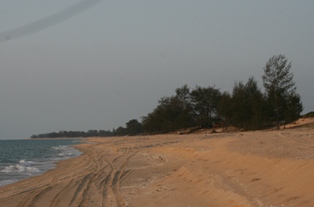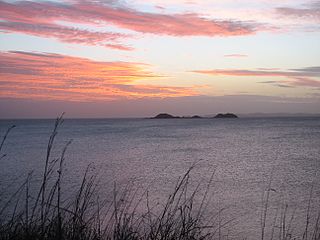
Cape York Peninsula is a peninsula located in Far North Queensland, Australia. It is the largest unspoiled wilderness in northern Australia. The land is mostly flat and about half of the area is used for grazing cattle. The relatively undisturbed eucalyptus-wooded savannahs, tropical rainforests and other types of habitat are now recognised and preserved for their global environmental significance. Although much of the peninsula remains pristine, with a diverse repertoire of endemic flora and fauna, some of its wildlife may be threatened by industry and overgrazing as well as introduced species and weeds.

The Pennefather River is a river located on the western Cape York Peninsula in Far North Queensland, Australia.

North Queensland or the Northern Region is the northern part of the Australian state of Queensland that lies just south of Far North Queensland. Queensland is a massive state, larger than many countries, and its tropical northern part has been historically remote and undeveloped, resulting in a distinctive regional character and identity.

Bamaga is a small town and locality about 40 kilometres (25 mi) from the northern tip of Cape York in the north of Queensland, Australia. It is within the Northern Peninsula Area Region. It is one of the northernmost settlements in continental Australia and is the administrative centre for the Northern Peninsula Area Regional Council.

Pormpuraaw is a coastal town and a locality in the Aboriginal Shire of Pormpuraaw, Queensland, Australia. Pormpuraaw is an Aboriginal community situated on the west coast of Cape York Peninsula approximately halfway between Karumba and Weipa on the Edward River. It is 650 kilometres (400 mi) by road from Cairns. Pormpuraaw currently has a 4-man police station.

Injinoo is a coastal town in the Northern Peninsula Area Region and a locality split between Northern Peninsula Area Region and the Shire of Torres in Far North Queensland, Australia. It is on the north-western coast of Cape York Peninsula. In the 2016 census, Injinoo had a population of 561 people.

Mapoon is a coastal town in the Aboriginal Shire of Mapoon and a locality split between the Aboriginal Shire of Mapoon and the Shire of Cook in Queensland, Australia. In the 2016 census, Mapoon had a population of 317 people.

New Mapoon is a town in the Northern Peninsula Area Region and coastal locality split between the Northern Peninsula Region and Shire of Torres, Queensland, Australia. In the 2016 census, New Mapoon had a population of 383 people.
Urradhi is a Paman language of the Cape York Peninsula of Queensland, Australia, and is apparently extinct. It was spoken by the Urradhi people. Urradhi proper is the south-western dialect of the language. The name is composed of urra "this" and the proprietive dhi "having". The south-eastern dialect of the same language, Wudhadhi, is made of the same elements, wudha being "this". These are part of a group of closely related and highly mutually intelligible dialects, these being Angkamuthi to the north of Urradhi, Atampaya inland from these, Utudhanamu inland north from Atampaya, Yantaykenu further north, being the language of the Bamaga area, Yadhaykenu on the east coast north of Wudhadhi, and Yaraytyana further north again. This group has no common language name, though Urradhi is commonly used as a cover name. It is unknown when it became extinct.
Anguthimri is an extinct Paman language formerly spoken on the Cape York Peninsula of Queensland, Australia, by the Anguthimri people who lived in the area from the mouth of the Mission River north to Pennefather River and west to Duyfken Point. It is unknown when it became extinct.

The Shire of Cook is a local government area in Far North Queensland, Australia. The Shire covers most of the eastern and central parts of Cape York Peninsula, the most northerly section of the Australian mainland.

The Northern Peninsula Area Region is a local government area in Far North Queensland, Australia, covering areas on the northwestern coast of Cape York Peninsula. It was created in March 2008 out of three Aboriginal Shires and two autonomous Island Councils during a period of statewide local government reform. In June 2018, the area had a population of 3,069.

The Bloomfield River is a river in the Wet Tropics of Far North Queensland, Australia, noted for its Bloomfield River cod fish species, found only in the river.

Port Musgrave is a shallow, almost enclosed, estuarine bay located on the western coast of the Cape York Peninsula in Far North Queensland, Australia.

The Wujal Wujal Aboriginal Shire is a local government area in Far North Queensland, Australia. It is managed as a Deed of Grant in Trust under the Local Government Act 2004.
Mbiywom (Mbeiwum) is an extinct Australian Aboriginal language formerly spoken by the Mbiywom people around the areas of Cape York and Cook Shire in Far North Queensland.

Umagico is a town and coastal locality in the Northern Peninsula Area Region, Queensland, Australia. In the 2016 census, Umagico had a population of 427 people.
The Ngathokudi (Ngadhugudi) were an indigenous Australian people of the state of Queensland. Their language was possibly a dialect of Uradhi.
The Nggamadi were an indigenous Australian people of the Cape York Peninsula of northern Queensland.
Duyfken Point is a point in the locality of Mission River, Shire of Cook, Queensland, Australia.











